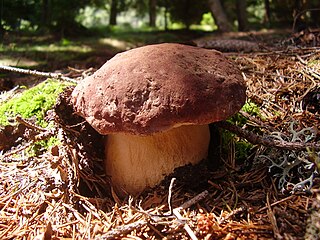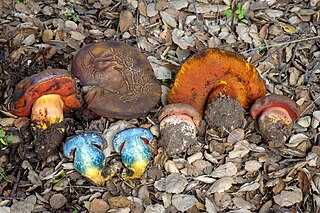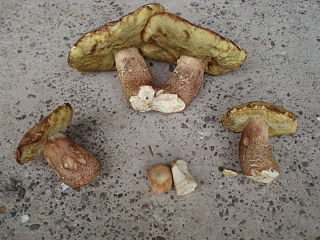
Boletus edulis is a basidiomycete fungus, and the type species of the genus Boletus. Widely distributed in the Northern Hemisphere across Europe, Asia, and North America, it does not occur naturally in the Southern Hemisphere, although it has been introduced to southern Africa, Australia, New Zealand, and Brazil. Several closely related European mushrooms formerly thought to be varieties or forms of B. edulis have been shown using molecular phylogenetic analysis to be distinct species, and others previously classed as separate species are conspecific with this species. The western North American species commonly known as the California king bolete is a large, darker-coloured variant first formally identified in 2007.

Boletus is a genus of mushroom-producing fungi, comprising over 100 species. The genus Boletus was originally broadly defined and described by Carl Linnaeus in 1753, essentially containing all fungi with hymenial pores instead of gills. Since then, other genera have been defined gradually, such as Tylopilus by Petter Adolf Karsten in 1881, and old names such as Leccinum have been resurrected or redefined. Some mushrooms listed in older books as members of the genus have now been placed in separate genera. These include such as Boletus scaber, now Leccinum scabrum, Tylopilus felleus, Chalciporus piperatus and Suillus luteus. Most boletes have been found to be ectomycorrhizal fungi, which means that they form a mutualistic relationship with the roots system of certain kinds of plants. More recently, Boletus has been found to be massively polyphyletic, with only a small percentage of the over 300 species that have been assigned to Boletus actually belonging there and necessitating the description and resurrection of many more genera.

Boletus aereus, the dark cep or bronze bolete, is a highly prized and much sought-after edible mushroom in the family Boletaceae. The bolete is widely consumed in Spain, France, Italy, Greece, and generally throughout the Mediterranean. Described in 1789 by French mycologist Pierre Bulliard, it is closely related to several other European boletes, including B. reticulatus, B. pinophilus, and the popular B. edulis. Some populations in North Africa have in the past been classified as a separate species, B. mamorensis, but have been shown to be phylogenetically conspecific to B. aereus and this taxon is now regarded as a synonym.

Boletus reticulatus, and commonly referred to as the summer cep is a basidiomycete fungus of the genus Boletus. It occurs in deciduous forests of Europe, where it forms a symbiotic mycorrhizal relationship with species of oak (Quercus). The fungus produces fruiting bodies in the summer months which are edible and popularly collected. The summer cep was formally described by Jacob Christian Schäffer as Boletus reticulatus in 1774, which took precedence over B. aestivalis as described by Jean-Jacques Paulet in 1793.

Boletus barrowsii, also known in English as the white king bolete after its pale colored cap, is an edible and highly regarded fungus in the genus Boletus that inhabits western North America. Found under ponderosa pine and live oak in autumn, it was considered a color variant of the similarly edible B. edulis for many years.

Boletus pinophilus, commonly known as the pine bolete or pinewood king bolete, is a basidiomycete fungus of the genus Boletus found throughout Europe and western Asia. Described by Italian naturalist Carlo Vittadini in 1835, B. pinophilus was for many years considered a subspecies or form of the porcini mushroom B. edulis before genetic studies confirmed its distinct status. In 2008, B. pinophilus in western North America were reclassified as a new species, B. rex-veris. B. pinophilus is edible, and may be preserved and cooked.

Butyriboletus appendiculatus is an edible pored mushroom that grows under oaks and other broad leaved trees such as beech. It is commonly known as the butter bolete. It often grows in large colonies beneath the oak trees, and is frequently found cohabiting with old oaks in ancient woodland. It is relatively rare in Britain. Its stipe and pores are often bright yellow and its flesh stains bright blue when cut or bruised.

Suillellus amygdalinus is a fungus of the bolete family found in western North America. The fruit bodies, or mushrooms, are characterized by their thick, red to brown caps, red pores, and the strong bluing reaction observed when the mushroom tissue is injured or cut. The cap can reach diameters of up to 12 cm (4.7 in) and the stipe 9 cm (3.5 in) long by 3 cm (1.2 in) thick at maturity. This mushroom has been found in manzanita and madrone woodlands of central California north to southern Oregon. Although the edibility of the mushroom is not known with certainty, it may be poisonous, and is not recommended for consumption. Other similar red-pored, bluing boletes from North America, including Rubroboletus eastwoodiae, Boletus luridiformis, and B. subvelutipes, can be distinguished from S. amygdalinus either by the color of the cap, the degree of reticulation on the stipe, or by location.

Boletus regineus, commonly known as the queen bolete, is an edible and highly regarded fungus of the genus Boletus that inhabits southwestern North America. It was considered a variant of the similarly edible B. edulis for many years until declared a unique species in 2008. Phylogenetic analysis has shown B. regineus as a member of a clade, or closely related group, with B. subcaerulescens, Gastroboletus subalpinus, B. pinophilus, B. fibrillosus, and B. rex-veris.

Caloboletus rubripes, commonly known as the red-stipe bolete or the red-stemmed bitter bolete, is a mushroom in the family Boletaceae. It was known as Boletus rubripes until 2014. Fruit bodies (mushrooms) are robust, with caps up to 18 cm in diameter, atop thick stipes 5–12 cm long. Mushrooms are non-toxic, but is so bitter as to be inedible. The mushroom flesh has a very strong bluing reaction when cut or damaged. and forms mycorrhizal relationships, primarily with conifers. It can be differentiated from similar boletes by its cap color and non-reticulate stipe.

Boletus fibrillosus is a basidiomycete fungus of the genus Boletus found in western North America. The fruiting bodies are found in mixed coastal forests in the fall, usually singly or in small groups. The cap is up to 17 cm wide, buff to brown to dark brown in color, and has a wrinkled to finely fibrous texture. The tubes are yellow, while the flesh is white to buff and does not stain when cut. The stem is yellowish at the top, brown otherwise, with a reticulate texture, and mycelium enshrouding the bottom. The holotype was collected in Mendocino County, California. The species is edible, but considered to have inferior taste to other edible boletes such as B. edulis, which it is often confused with.

Boletus subcaerulescens is a basidiomycete fungus of the genus Boletus found in northeastern North America. The fruiting bodies are found associated with pine and spruce. The cap is up to 18 cm wide, convex to flat, and brown in color. The tubes are yellow and stain blue when bruised, while the flesh is white to buff and does not stain when cut. The stem is brown like the cap and has a light-colored reticulate texture.

Boletus variipes is a species of mycorrhizal bolete fungus in the family Boletaceae, native to North America. It was originally described by American mycologist Charles Horton Peck in 1888.
Boletus mamorensis is an edible fungus of the genus Boletus native to Morocco. It is closely related to B. aereus.

Sutorius eximius, commonly known as the lilac-brown bolete, is a species of fungus in the family Boletaceae. This bolete produces fruit bodies that are dark purple to chocolate brown in color with a smooth cap, a finely scaly stipe, and a reddish-brown spore print. The tiny pores on the cap underside are chocolate to violet brown. It is widely distributed, having been recorded on North America, South America, and Asia, where it grows in a mycorrhizal relationship with both coniferous and deciduous trees.
Dennis Edmund Desjardin is an American mycologist. He has been called the "Mushroom Guru of the West Coast".
Boletus hiratsukae is a basidiomycete fungus of the genus Boletus found in Japan. Described by Japanese mycologist Eiji Nagasawa in 1994, it is named after Naohide Hiratsuka. It is characterized by a grey-purple then brown pileipellis and a reticulated stem near the hymenium. It is close to Boletus edulis.

Boletus nobilis, the noble bolete, is a species of edible basidiomycete mushroom of the genus Boletus found in eastern United States. Morphologically close to Boletus edulis, it is distinguished by an elongated stem, a beige skin and white pores, even when old.

Boletus nobilissimus is an edible basidiomycete mushroom, of the genus Boletus in the family Boletaceae. Long considered a variety of European Boletus edulis, it has become a species on its own in 2000, with 2010 molecular study finding that it is most closely related to B. atkinsonii, B. quercophilus of Costa Rica and then B. barrowsii of western United States. It is found in abundance in open oak forests after heavy rains and warm weather.















